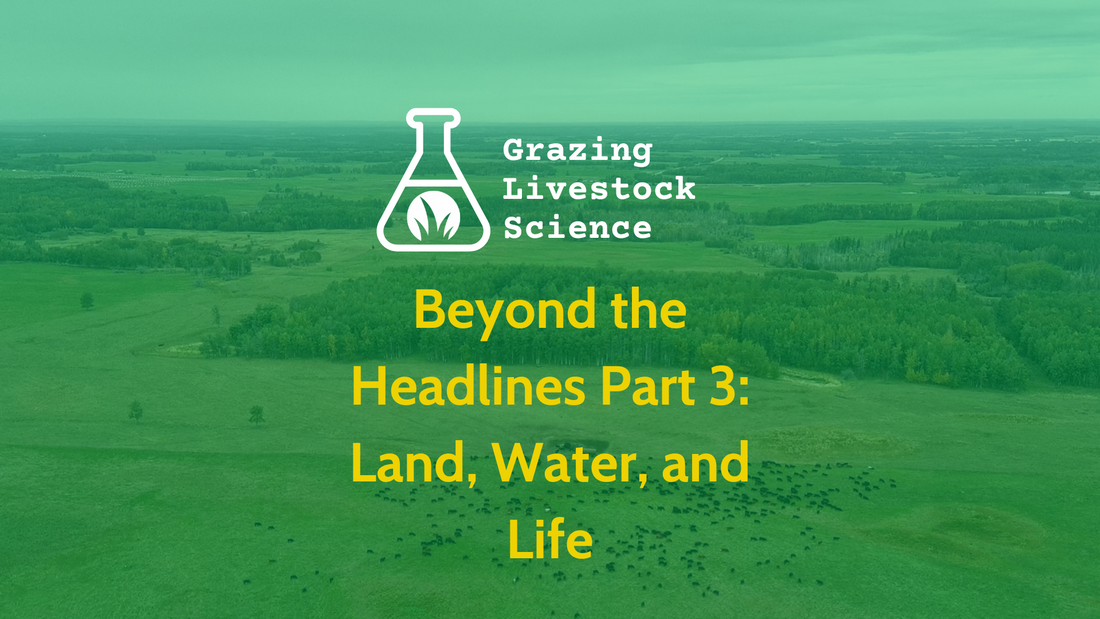
Beyond the Headlines Part 3: Land, Water, and Life
In the third installment of our series on sustainable livestock agriculture, we're exploring another area often misunderstood in popular conversations: how livestock interact with land, water, and biodiversity. These relationships are far more complex—and often more positive—than most headlines would have you believe.
The Land Use Reality
One of the most common criticisms of livestock production is that it uses too much land. While it's true that grazing livestock and growing feed occupy substantial land area globally, this simplified view misses several crucial points:
Upcycling Marginal Land
About 70% of agricultural land is grassland that cannot support crop production. This land is often too steep, rocky, dry, wet, or nutrient-poor for growing crops. Ruminant animals like cattle can convert these otherwise "unproductive" lands into nutritious food for humans.
According to global studies, crops use approximately 12% of the Earth's land surface, while livestock utilize an additional 37%. However, much of this livestock land cannot be repurposed for growing human food crops.
When we properly account for the productivity of land, we see that grazing animals aren't competing with human food production—they're complementing it by making use of land that would otherwise not contribute to our food system.
Building Soil Carbon
Well-managed grazing doesn't just produce food—it can actively improve soil health and carbon sequestration:
- Grazing animals stimulate plant growth through properly timed grazing
- Their manure returns nutrients to the soil
- Their hooves press seeds into the ground and break up compacted soil surfaces
- Properly managed grazing helps plants develop deeper, more extensive root systems
These processes can contribute to building soil organic carbon—essentially storing carbon underground rather than in the atmosphere. While permanent grasslands eventually reach an equilibrium state where carbon gains equal losses, the period to reach this equilibrium can span decades, during which time significant carbon sequestration occurs.
Even at equilibrium, maintaining these carbon-rich soils through good management prevents the large carbon losses that would occur if these lands were converted to cropland or degraded through poor management.
Water: Beyond Simple Footprints
Water footprinting is another area where simplified metrics often misrepresent livestock's impact. Common accounting methods attribute enormous water usage to livestock production, but a closer look reveals important nuances:
Green Water vs. Blue Water
Water footprint calculations often include "green water"—essentially rainfall that falls on grazing lands. This approach is problematic because:
- Rainfall would fall on this land regardless of whether livestock are present
- Most rainwater on grazing lands infiltrates into the ground, recharging groundwater and feeding streams
- Little water is actually "consumed" or removed from the local water cycle
A more meaningful approach focuses on "blue water" (from groundwater or surface water sources) that is actually consumed or diverted from other potential uses. When assessed this way, well-managed grazing systems in appropriate environments often have minimal impact on water availability.
Soil Health and Water Cycles
Healthy soils in well-managed grazing systems actually improve water cycles by:
- Increasing water infiltration rates
- Reducing runoff and erosion
- Improving water-holding capacity
- Filtering water and improving its quality
Research shows that high-carbon, well-structured soils typical of properly managed grasslands can hold significantly more water than degraded soils. This increased water-holding capacity helps mitigate both flood and drought risks—a critically important ecosystem service in the face of climate change.
As one study noted, "The increased water-holding capacity of high-carbon soils, typical of grazed grasslands, has practical implications for reducing flood risks, a vital service of our ruminant grassland systems."
Biodiversity Benefits
Perhaps the most overlooked aspect of the livestock conversation is the potential for well-managed grazing to actively support biodiversity:
Habitat Creation and Maintenance
Many of the world's grassland ecosystems co-evolved with grazing animals over millions of years. These ecosystems—and the countless species that inhabit them—depend on grazing to maintain their ecological balance:
- Grazing prevents single plant species from dominating
- It creates structural diversity in vegetation heights and density
- It cycles nutrients and creates microsites for seed germination
- It maintains open habitats needed by many ground-nesting birds and other grassland specialists
Without grazing, many of these ecosystems would transition to different states—often with lower overall biodiversity. For example, studies have documented how the removal of grazing can lead to the decline of ground-nesting birds that require short vegetation structures.
Mixed Farming Benefits
When crops and livestock are integrated in mixed farming systems, biodiversity often increases through:
- More diverse landscape structures
- Increased habitat heterogeneity
- Enhanced soil biodiversity from manure inputs
- Greater plant diversity in rotational systems
At Modern Pastures, our partner farmers implement practices that specifically enhance biodiversity on their farms, including:
- Maintaining diverse pasture plant communities
- Protecting riparian areas and wetlands
- Creating habitat corridors and buffer zones
- Using rotational grazing to mimic natural herbivore impacts
Context Matters Most
If there's one message to take away from this discussion, it's that context matters tremendously when assessing livestock's environmental impact:
- A feedlot in a water-scarce region has very different water impacts than grass-based production in a rain-abundant area
- Grazing on land converted from rainforest has different biodiversity implications than grazing on native grassland
- Concentrated production that pollutes waterways differs dramatically from well-managed systems that build soil health
This is why Modern Pastures is committed to transparency about our sourcing practices. We believe consumers deserve to know not just what they're eating, but how it was produced and in what context.
The Path Forward
Rather than simply criticizing all livestock production based on oversimplified metrics, we should be working toward systems that maximize the potential benefits while minimizing negative impacts. This means:
- Appropriate land use: Using grazing animals primarily on lands unsuitable for crop production, while integrating livestock into cropping systems where beneficial.
- Context-specific water assessment: Focusing water conservation efforts where it truly matters—in water-scarce regions and systems that consume significant blue water.
- Biodiversity-enhancing management: Implementing grazing practices that support rather than harm ecosystem functioning and biodiversity.
- Holistic assessment: Looking beyond single metrics to understand the full range of impacts and benefits from different livestock systems.
Choosing Better Meat
As a conscious consumer, you can support these better approaches by:
- Choosing meat from farmers who implement regenerative grazing practices
- Supporting brands like Modern Pastures that prioritize transparency about production methods
- Understanding that it's not about whether to eat meat, but about how that meat is produced
- Considering the full context of production rather than focusing on simplified metrics
By making these informed choices, you're helping build a food system that works with rather than against natural processes—one that can provide nutritious food while enhancing rather than degrading our planet's ecosystems.
In our next and final post in this series, we'll tie together these threads to see how Modern Pastures is putting these principles into practice as we work to transform our food system.
Modern Pastures is a farm-direct meat company based in Western Canada, in a region perfectly suited for grazing beef and other ruminants.
The article that was the primary source for this series can be found at https://doi.org/10.1093/af/vfac096
